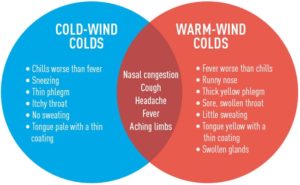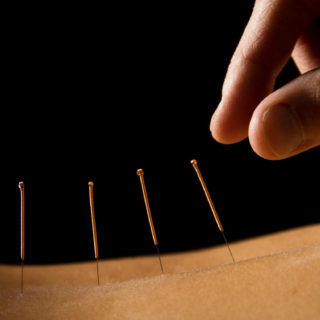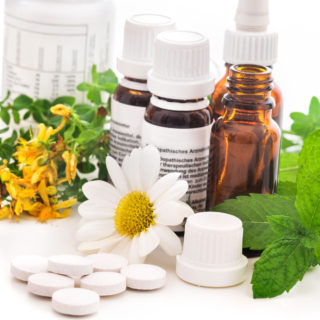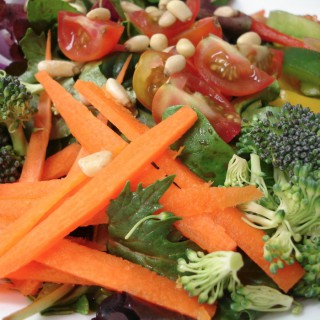Not only we are in a global pandemic but we are also in a time of cold and flu season again as we dive deeper into winter. In conventional western medicine, infectious diseases, including the common cold and flu, are understood to be caused by bacteria or viruses.
However, when Chinese medicine was founded over 4000 years ago, there was no known concept of bacteria or viruses. At that time, Chinese medicine saw acute respiratory diseases as caused by “Wind”, or other exterior climatic factors when the body’s energy is out of balance with nature and changes in weather. This is seen as a temporary imbalance between nature and the body at a given time.
Incidentally though, the written traditional Chinese character for “wind” 風 contains the character for “insect” 虫 – as it is understood that wind is a means for insects to travel and thereby infect whole regions with disease. And you could say the Chinese term for “insect” includes those microscopic ‘bugs’ that we call bacteria and viruses today.
There are six exterior pathogenic (disease-causing) factors in Chinese medicine simply described as follows: Wind, Cold, Heat, Dampness, Dryness and Summer Heat.
So when these exterior pathogens are particularly strong, or the body’s defenses are weak when exposed to these factors, then acute infectious diseases occur, first impacting the respiratory system.
According to traditional Chinese medicine (TCM) then, the disease-causing factors in common colds and flus involve Wind, Cold and Heat.
The characteristics of pathogenic wind are the following:
- Always enter through the skin pores, especially when immune system is low, or when sweating has occurred; strong wind, even an air conditioning wind further opens the skin pores
- Cause rapid onset of symptoms
- Cause rapid changes in symptoms
- Cause migratory pain in the body as it moves through the tissues
- Cause various harm to different body
 tissues
tissues
- Complicated by other pathogenic factors such as cold and heat
When pathogenic Wind is complicated by other factors such as Cold or Heat, then we can have two types of common colds, either the Wind-Cold syndrome, or the Wind-Heat syndrome. Both can rapidly transform into the other within just a matter of days and become bronchitis or pneumonia, or trigger asthma attacks.
See chart below with key differentiating symptoms noted in capital letters.
| Type of External Syndrome | Pathogens | Symptoms | Treatment Principle | Remedies |
| Wind-Cold | Wind + Cold
(from weather, or air conditioning) |
ACHY BODY, stiff neck; no sweating; stuffy or runny nose, CHILLS more than fever; possible cough with clear, white or no mucus | Release the exterior, dispel cold | Ginger-honey tea, Sweat in sauna, hot baths with epsom salts, cupping, tailored herbs; Shiatsu therapy, acupuncture |
| Wind-Heat | Wind + Heat
(from weather or house too dry-hot in winter) |
SORE THROAT; mild sweat; FEVER more than chills; stuffy nose with YELLOW-green MUCUS; possible cough with yellow-green mucus | Dispel wind, release the exterior, clear heat | Yin Qiao Pian, or Chuanbei Pei Pa Gao cough syrup, or tailored herbs, cupping; prick to bleed apex of ears to immediately relieve fever or sore throat; acupuncture, shiatsu therapy |
5 Prevention Tips for Cold & Flu Season
- Avoid being outside in any excessive wind or cold, and if you exercise outdoors to the point of sweating, then when finished immediately take a hot shower before the sweat dries and cools on your body.

- When going for walks outdoors, cover your neck and head, and take some hot tea or hot water with you.
- Keep your iron levels up – iron deficiency leads to low immunity, and is a cause for so many preventable conditions. Ferritin (storage of usable iron in the liver) should be about 100 (normal range is 14-247 ug/L for most labs). And Hemoglobin (count of iron attached to red blood cells and in use right now carrying oxygen throughout the body) should be in the middle of the range (which varies significantly depending on the lab).
- For adults, take a regular daily dose of 5000 IU liquid Vitamin D3. Children can have 500 IU/day. Take sublingually (under the tongue) for most effective results.
- Reduce intake of rich food, spicy food and alcohol as these can aggravate a cold or flu if you are exposed to exterior pathogens.
5 Remedy Tips at Onset of Catching Cold or Flu
- Take extra liquid Vitamin D3 sublingually – 20,000-30,000 IU per day for 3 days if you start to feel any cold or flu symptoms start. Children can take 1000-2000 IU per day for 3 days if symptoms start.
- Go to bed EARLY and get a good rest for 2-4 nights! This is one of the best remedies, especially if you can be asleep by 9:00PM.
- Take 10 drops per day sublingually for 5 days of suitable oral intake oregano oil.
- Visit your TCM doctor, Chinese herbalist or TCM herbal store to get Yin Qiao Pian patented formula, or tailored herbs designed for your constitution and specific symptoms.
- See your TCM specialist to get cupping done. And if you have sore throat or fever, doing wet cupping at the back of the neck, or pricking the apex of the ears to bleed a few drops is best to alleviate these heat symptoms.



















Hey nice job, thanks for all the good advice! I personally take vitamin C by supplementation or with Goji berries!
Great tips.
And Indeed, I’m Just Always Astounded Concerning the Remarkable Things Served by You. Some Four Facts on This Page Are Undeniably the Most Effective I’ve Had.